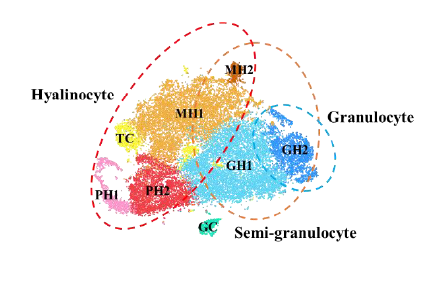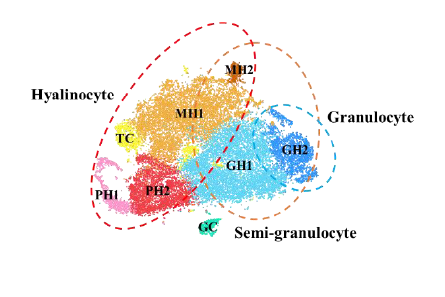In this new research by Wang Fan the shrimp immune cell marker genes were compared with their human homologs to identify evolutionary traces of innate immune cells between invertebrates and vertebrates. This study analyzes shrimp hemocytes via single-cell sequencing and redefines their classification according to their 72 functional marker gene distribution. The research performed subtyping of shrimp immune cell clusters and constructed their differentiation trajectory. Also, the evolutionary phagocyte development along the metazoan tree of life is examined.
The study proposes a novel crustacean hemocyte classification system with an important mariculture species, Penaeus Vannamei (Whiteleg Shrimp), as the crustacean model. Using this system, the research identifies a new functional monocytic hemocyte lineage for circulating shrimp hemocytes. As the terminally differentiated cells of this lineage share several functional genes with mammalian macrophages, this research suggests that the monocytic hemocyte lineage might be an invertebrate evolutionary homolog of the vertebrate monocyte lineage.
The study identifies prohemocytes, monocytic hemocytes, and granulocytes as the three major cell-types in the white shrimp hemolymph using single-cell RNA-sequencing. Results identified a novel macrophage-like subset called monocytic hemocytes 2 (MH2) in shrimp hemolymph, defined by the expression of certain marker genes, including Nlrp3 and Casp1. This subtype of shrimp hemocytes is phagocytic and expresses markers that indicate some conservation with mammalian macrophages. In other words, this research suggests that MH2 may be an invertebrate homolog of human macrophages.
The identification of the two well-known mammalian macrophage inflammasome components, Nlrp3 and Casp1, suggest that inflammasome-mediated anti-pathogenic processes might exist in invertebrate innate immunity and play a role in microbial restriction. The presence of NAGA, another enzyme found in macrophages, in shrimp phagocytes implies that this subset of cells might share similar negative regulatory mechanisms recently partially uncovered in vertebrate macrophages. VEGF3, a well-known angiogenic factor, was also identified in this subtype; whether this factor plays a role in healing wounds needs further research and studies.
The research compared their newly identified classification with the traditional classification of shrimp hemocytes into hyalinocytes, semi-granulocytes, and granulocytes. The research data clearly indicates that the small cells, though similar in morphology, include both prohemocytes and phagocytic hemocytes, and these two subtypes of cells have different marker genes and varied functional roles in the shrimp hemolymph. The results also show that the cells sorted as semi-granulocytes contain both monocytic hemocytes and cells of granulocyte lineage.

The proposed model for comparison between two classifications. The hyalinocyte, semi-granulocyte, and granulocyte were labelled on the t-SNE map with red, brown, and blue circles respectively.
This research work resolves the heterogenicity of hemocytes in this economically significant aquatic species (Whiteleg Shrimp) and identifies a novel innate immune cell subset that can possibly become a critical player in the immune responses of shrimp to the threatening infectious diseases affecting this industry.
This novel research provides a different interpretation for the current crustacean immune cell subtyping as well as valuable insights about crustacean cellular immunity in the future. Being at an early stage of research about the cellular immunity in shrimp, this study finds that some fundamental questions still remain unresolved, such as: Can shrimp macrophage-like phagocytes infiltrate various tissues and where do the circulating shrimp prohemocytes originate? In future studies, this research group intends to find answers to such questions to understand more about this shrimp species and find solutions to various shrimp diseases that have caused tremendous economic losses worldwide.
About the author:

Wang Fan is an Associate Professor in the Department of Biology at Shantou University. He received a B. E. in Chemical Engineering from Tsinghua University in 2000 and received an MSc in Biochemistry, working in the laboratory of Dr. Zhou Haimeng. He did his Ph.D. work at the National University of Singapore in Dr. Hew Choy Leong’s lab. There he explored how phosphorylation regulated iridovirus assembly. As a postdoctoral fellow, he worked with Dr. Fu Xinyuan at the National University of Singapore, where he used STAT3 conditional knockout mice to study how STAT3 affects the epigenetic regulation of innate immunity.
He joined Shantou University in February 2016 and his lab is located in the high-level university experimental building. Fan’s lab is applying Penaeus Vannamei-a marine invertebrate animal as a model to study cellular immunity. Recently he has discovered several novel plasma factors’ functions that are conserved from shrimp to human and redefine shrimp immune cell subtyping. A central focus of Fan’s current work is to address fundamental questions in immunology, with an emphasis on epigenetic regulation of innate immune memory.
Media Contact
Company Name: Index of Sciences Ltd
Contact Person: Stella Richards
Email: Send Email
Phone: +441442781196
Address:Kemp House 160 City Road
City: London
State: England
Country: United Kingdom
Website: https://elifesciences.org/articles/80127
